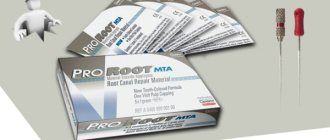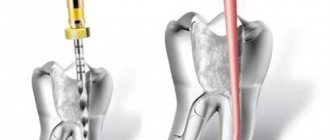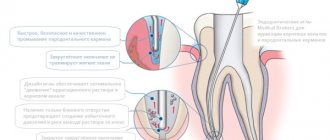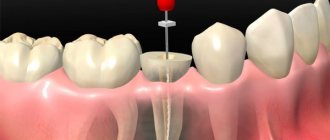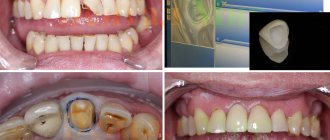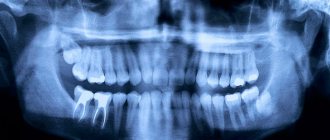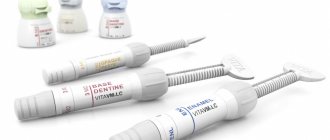If a tooth is destroyed by caries or as a result of injury, it must be restored, otherwise the tooth can be lost, and the absence of even one dental unit in a row is fraught with the most unpleasant consequences for health. For example, due to the absence of a tooth, an incorrect bite may develop, which leads to disruption of the correct process of chewing food and the development of various diseases of the digestive system.
If the tooth is slightly damaged, then most likely the doctor will use a regular, light-curing filling to restore it. But if the damage is significant, it would be more correct to use a stump tab.
Many people do not even know what kind of structure this is - a stump tab and for what purpose it is used by dentists. Meanwhile, the use of stump inlays makes it possible to successfully restore teeth that at first glance seem completely hopeless and must be removed.
In the article we will tell you in detail about what stump inlays are, what types of them exist, and why severely damaged teeth are best restored with inlays, and not with fillings and pins.
What is a stump tab and why is it needed?
A stump inlay is not a filling or a seal on a post. This is a specialized orthopedic design that is produced in a dental laboratory and is used to restore teeth that have been more than half destroyed by caries or trauma.
Of course, even a badly damaged tooth can be restored with a filling on a pin and then a prosthesis can be placed on it. But such an approach to prosthetics will be wrong, since large fillings, even if attached to pins, are simply not capable of holding well. The load on the tooth will sooner or later lead to the filling on the pin falling out along with the prosthesis, and then the tooth will have to be re-treated.
Stump inlays help to avoid such unpleasant consequences - they are firmly fixed in the root canal of the tooth and the dental crown is fixed on them. Externally, the inlays are very similar to stumps - ground teeth - hence their name.
Stages of restoration of a tooth stump for a crown
Stage 1. Preparing the tooth core
Preparation of the tooth stump consists of a small preparation in order to remove unreliable fragments of the composite core material.
After this, according to the adhesive protocol, the acid was applied for 15 seconds, rinsed off generously, the surface was left slightly moistened, and the adhesive system was applied.
I used All Bond 3 adhesive (Bisco IL, USA). This is a universal dual-curing adhesive; it has a modified structure of the polymer matrix and is maximally stable on the dentin substance after polymerization due to its hydrophobicity. After preparation and polymerization, the dentin surface has a shiny appearance. This is good.
Stage 2 Crown preparation
The inner surface of the crown is covered with insulating material. I used PRO-V-COAT (BISCO, IL USA)
This material creates a completely inert surface that prevents the fixation of any composite. In addition, it is highly washable and was originally intended to isolate the surface of the tooth structure from the temporary composite material in InLay & Overlay cases. But you can also use glycerin or water-soluble gel lubricant.
Materials used for the adhesive fixation technique: All Bond 3 adhesive, primer for zirconium oxide, aluminum and metal Z-PRIMER PLUS, light-curing composite cement Choise2.
Prepared tooth stump for restoration
Stump restored along the crown.
The crown is carefully removed from the restored tooth stump. This process is accompanied by light effort. The crown is very clearly fitted to the restored tooth stump. The use of release agents (in my case, PRO-V COAT) makes this procedure always predictable.
Stage 3 Fixing the crown on the tooth
I use an adhesive bonded aluminum oxide crown. To do this, the inner surface of the aluminum oxide crown is sandblasted using aluminum oxide powder 50 microns at a pressure of up to 2 atm. at an oblique angle to the surface.
Degrease in alcohol or acetone and dry. A primer for zirconium oxide and aluminum Z-PRIMER PLUS (BISCO,IL USA) is applied to the inner surface of the crown for 30 seconds. Drying. The surface of the crown is ready.
The inner surface of the framework ceramics is treated with the primer Z-PRIMER PLUS (BISCO, IL)
The newly created tooth stump is subjected to an adhesive protocol: etched, All Bond 3 adhesive is applied, and polymerized.
We add light-curing composite cement to the crown.
The crown is adapted to the tooth stump. Excess cement undergoes 2 second polymerization. are removed from the edges of the crown and transcoronal polymerization is carried out on each side for 30 seconds.
Some comments and clarifications on cement for fixing dental crowns:
- When working with metal-ceramics, I use chemical or dual-curing composites (Luxa-Core (DMG), Core-Flo, Bisfill 2B (Bisco)) as core materials.
- The surface of the tooth stump when using chemical or dual-curing materials must be coated with adhesive systems compatible with such materials.
Why are core inlays better than fillings and pins?
Fillings and pins are only applicable if the tooth has a sufficient amount of healthy tissue remaining. If only the root or thin walls of the tooth remain, then it cannot be restored with a pin, since such a restoration method will not be distinguished by either quality or reliability.
Firstly, under load, the pin can break and in the process damage the tooth root. Trauma to the root of a tooth is a direct indication for its removal; no methods for damaging the root system will help you save your tooth.
Secondly, dentures installed on large fillings and pins most often fall out some time after prosthetics. In this case, the treatment will have to be carried out again, and this implies new and significant financial costs.
IMPORTANT: Some dentists try to fix the fallen crown and pin with cement. But this is useless: the structure will not hold firmly, and in addition, an inflammatory process may begin under it, leading to rotting and destruction of the tooth.
Therefore, in case of severe tooth decay, only a stump inlay can provide high-quality and durable prosthetic results.
Grigoriev Alexander.
SCAD member, academic director. International lecturer on adhesion and interdisciplinary restoration.
Highly aesthetic works from metal ceramics, press ceramics and frame ceramics on zirconium and aluminum oxide are a reality today. The skills and craftsmanship of the medical technician team create masterpieces that stun patients with their results. Today, aesthetic rehabilitation services can improve the patient’s personal status and sometimes change their fate.
But there is also a downside to this happiness: a chip of a fragment of ceramics, a chip of a veneer, a disintegration of an orthopedic crown, and sometimes even a defect in the tooth stump. Moments of happiness stop at this moment for our patient. The beloved restoration is no longer pleasing to the eye.
Using the example of one clinical case, I will show how to effectively and accurately carry out the inversion (reverse) prosthetics method.
Patient M., 35 years old, came to the clinic with complaints of decementing of an aluminum oxide crown by 2.1.
Objectively: the crown had a movable position on the stump of tooth 2.1 and was removed without effort. A chipping of 1/3 of the tooth stump was noted (the inner part of the crown was filled with the separated fragment).
Defect of stump of 2.1 tooth
In the past, the tooth was subjected to endotherapy followed by restoration using a polymer post. There was complete preservation of the polymer pin throughout. Only the inner surface of the crown with a fragment of core material broke off.
Types of stump inlays
Before installing a core inlay, it is imperative to treat the damaged tooth, remove all tissue damaged by caries, and also be sure to properly process and seal the root canals.
IMPORTANT: Root canal treatment is a process in which not the slightest mistake should be made! If the canals are treated poorly or improperly sealed, an inflammatory process may begin in them. In our dental clinic in Moscow - Firadent - treatment of tooth canals is carried out under a microscope, which allows the doctor to see the length and structural features of the canals and thus eliminate errors in the process of their treatment.
After treating the canals of the tooth, the orthopedic dentist begins to treat the patient: the specialist will unseal the canals to the length of the future stump inlay and take an impression for its manufacture. As we already wrote above, core inlays are produced in a dental laboratory.
There are several types of stump inlays. The classification of inlays is carried out according to the material of manufacture and the number of pins - fastenings with which the inlay will be firmly held in the tooth canals. The inlay may have several pins, their number is determined by the number of canals of the tooth being restored.
Based on the number of pins, the following types of stump inlays are distinguished:
- Single-rooted;
- Double-root collapsible and non-removable tabs;
- Three-root collapsible and non-removable stump inlays.
Multi-root inlays are most often made collapsible - this simplifies the process of securing the inlay in the tooth canals. But collapsible inlays are more expensive than non-demountable structures: the higher price is explained by the high complexity of manufacturing.
Restoration techniques
Technologies for tooth stump restoration used in dentistry are differentiated into two categories:
- Restoration using a special design. In case of minor damage to the crown, a traditional ceramic inlay acts in a similar capacity. However, the use of such a technique requires additional safety measures to prevent tooth decay after installation;
- Direct recovery. An anchor pin in combination with restoration material allows you to restore the chewing element, as well as correct the position of the remaining part of the tooth. At the same time, there are several types of materials, classified based on the specifics of their hardening, which expands the possibilities for choosing colors.
In addition, in case of significant damage to the crown, the use of glass ionomer material, either alone or in combination with polymer composites, is allowed. Advantages: absence of toxic reactions, strength and aesthetics, as well as the ability to adjust the product during the hardening process.
Recovery procedure
The sequence of actions to restore the stump includes the following steps:
- The preparation stage, during which the crown is ground, the canal cavity is expanded and strengthened, and the threaded groove is cut;
- Fixation of an artificial pin using a cement composition;
- After final hardening, the visible part of the structure is formed.
The finished structure must be protected from corrosion, take into account the characteristics of the root structure, and have sufficient strength and tightness. It is important to take into account that significant pressure will be exerted on the preserved root part, so the installed pin must compensate for the negative consequences of the load.
To eliminate large-scale damage, it is also possible to use techniques that do not require the installation of an artificial foundation. As an alternative, reinforced ceramics or a cement-based composite composition are used. In addition, monoblock cast inlays are used, but practice shows that due to the lack of shock absorption, they usually have a negative impact on the root structure.
Materials for manufacturing pin stump inlays
Stump pin inlays can be made from different materials - ceramics or metal. Stump inlays with metal pins are most often made from an alloy of cobalt and chromium and are used for the installation of metal or metal-ceramic prostheses.
Cobalt-chrome core inlays have a number of specific advantages:
- They have good biocompatibility with human body tissues;
- Stump pin inlays made of this metal alloy fit quite tightly to natural tissues and therefore, when used, the risks of caries, inflammatory processes and further tooth destruction are reduced;
- Cobalt-chrome alloy has high strength and therefore a crown installed on a pin insert made of this material will not shrink during operation.
Stump inlays made of cobalt-chrome alloy allow for proper distribution of the chewing load, which reduces the risk of cracks and tooth destruction. The advantages of inlays made from this material include their affordable cost.
Ceramic pin inlays are used for the installation of metal-free dentures. This allows you to obtain impeccable aesthetics of the restored tooth. If you place a metal stump insert under the ceramic structure, it can be quite noticeable and, of course, it will spoil the appearance of the restored tooth. Therefore, only ceramic pin inlays are placed under ceramics.
Why do teeth grind?
People who are encountering prosthetics or microprosthetics for the first time are often perplexed by the fact that the dentist grinds or prepares1 teeth. Why is this necessary? Everything is quite simple. Any prosthesis - crown, veneer, bridge, etc., has a certain thickness. Of course, it is very small, literally 1-2 millimeters for crowns, and sometimes even a fraction of a millimeter (for example, the average thickness of veneers is 0.5 mm). But the teeth themselves are not that big.
Read on the topic: what is turning and why it is carried out before prosthetics.
Therefore, if we consider a situation where the prosthesis is fixed to an unground tooth, then due to its thickness the prosthetic structure will protrude from the rest of the row - it looks ugly. And in contact areas with neighboring teeth, a crown or veneer simply “will not fit”, which will chip the enamel and injure the gums.
For crowns and bridges, in addition to the turning itself, it is important to create a ledge or “shoulder” - drill attachments are also used for this, as for the turning itself. The ledge looks like a smooth transition, with which the upper part of the stump “flows” to the outer border of the tooth root. By the way, the ground stump should resemble a cylinder, not a cone - this way the chewing load is better distributed. What grinded teeth look like is shown in the photo.
Also, turning is necessary to remove tissues affected by caries - otherwise an infectious focus will subsequently develop under the prosthesis. And for some types of orthopedic structures - in particular for veneers, it is important that the surface of the enamel underneath them is rough, with grooves. This way, artificial overlays stick better due to the adhesion effect.
How stump inlays are made: an overview of the main stages
Stump inlays are made individually for each patient. Treatment begins with an examination of the patient and consultation with two specialists – a general dentist and an orthopedic dentist.
Before an impression is taken from the tooth, according to which a stump insert will be made, high-quality sanitation of the oral cavity is carried out, and all diseases of the teeth and gums diagnosed during the examination are treated. The damaged tooth is treated: the nerve (pulp) is removed from it, and the canals are filled. This is where the work of the dentist-therapist ends and the orthopedist begins to care for the patient.
Further treatment will proceed according to the following scheme:
- The prosthetist will correctly prepare the tooth for installation of the stump inlay and select its type.
- When choosing the type of stump tab, the material of its manufacture and the type of tab (single-root or multi-root, cast or collapsible stump tab) are determined.
- Then the doctor will make an impression of the patient’s jaws, which will be sent to the dental laboratory, where a stump inlay will be made from the impression taken.
- Based on the impression, a model of the stump inlay is first made, and then a permanent structure is made from the selected material.
- The dental technician passes the finished stump inlay to the orthopedist.
After the stump inlay is ready, the patient is invited to the prosthetist’s office and the doctor installs the stump inlay in the tooth canals. A temporary prosthesis is put on the tab and a break is taken in the treatment until the crown is made, which the doctor fixes on the stump tab.
Indications for installation
- destruction of the coronal part;
- periodontal diseases (splinting);
- defects in the shape, position of the unit, supragingival area;
- There is no way to put a pin with a filling. For example, if the chewing units are destroyed.
Contraindications for installing a post-core restoration on a pin
: caries, cysts, damage or absence of roots, gum disease, periodontal disease, pathological mobility of the dentition, allergies to the alloys from which the structure is made.
We offer
:
- single crowns;
- veneers, lumineers;
- bridge-like devices;
- implant-supported restoration;
- systems with stump pin system.
Advantages and disadvantages of using stump inlays
The main advantage of stump pin inlays is the high reliability and durability of prosthetics. This design will firmly hold the installed dental prosthesis and, moreover, will allow for proper distribution of the chewing load. When using pin stump inlays, the risk of crown loss is reduced to zero.
Installing crowns on the stump inlay and pin allows you to increase the useful life of the prosthesis. In addition, core inlays help to obtain the ideal tooth shape and are suitable for restoration of anterior and chewing teeth.
There are only two disadvantages to the use of stump inlays - higher price and longer prosthetic time. On average, it takes about 2 weeks to make an inlay.
IMPORTANT: Only an experienced prosthetist can make a high-quality multi-root collapsible stump inlay. Therefore, it is so important to choose a clinic for your treatment that employs competent and qualified orthopedists and dental technicians and has its own, well-equipped dental laboratory. Our dentistry in Moscow, Firadent, 100% meets these conditions: your treatment with us will be carried out with impeccable quality and comfort!
Are there any contraindications to the use of stump pins?
Unfortunately, not in all cases, stump pin inlays can be used for dental prosthetics.
Stump inlays should not be used under the following circumstances:
- When a tooth is destroyed below the gum level;
- When the quality of root canal filling is poor. In this case, it is necessary to unseal the canals, reprocess and seal them, and only then install a pin stump inlay and crown;
- A contraindication to the use of a pin stump insert would be an inflammatory process in the area of the tooth root;
- Allergy to the materials used to make the stump inlay on the pin.
Also, inlays are not placed on loose and mobile teeth.
IMPORTANT: In some cases, a stump pin can still be installed even if the tooth is destroyed below the gum level. But this will first require an additional operation - an osteotomy. The essence of this operation is to cut down the bone tissue to such an extent that the gum is below the destroyed tooth.
Summary -
Very often, patients have to deal with the following situation... You come to the dentist with a decayed tooth. He recommends that you get a crown, but you need to do a root canal first. He treats root canals, screws a pin into the root, restores the crown of the damaged tooth and sends you to an orthopedist. An orthopedic dentist looks at the quality of the treated canals on an x-ray and says that instead of a pin, a stump inlay should be made.
As a result, you have to pay money again and have the tooth treated again - remove the filling, unscrew the pin. To prevent this from happening, you must immediately go for a consultation with an orthopedic dentist, who will draw up a treatment plan and write in the medical record for the dental therapist that the root canals only need to be treated without screwing pins into them, and that further it is planned to make a stump inlay. We hope that our article on the topic: What is a tab in dentistry under a crown was useful to you!
Sources:
1. Personal experience as a dentist, 2. “Orthopedic dentistry. Textbook" (Trezubov V.N.), 3. National Library of Medicine (USA), 4. "Orthopedic treatment with fixed prostheses" (Rozenstiel S.F.).
Dental care after the installation of a core tab
Stump inlays do not require complex specific care. All you need to do is maintain oral hygiene, brush your teeth regularly and undergo periodic dental examinations and professional hygiene procedures.
To clean crowns installed on teeth with core inlays, it is best to use brushes with soft bristles; it will also be useful to rinse your mouth after each meal - with a special balm or just clean water. When brushing your teeth, it is important to clean them from all sides and be sure to thoroughly clean the interdental spaces. For this purpose, special brushes and dental floss are used.
What to do with a ground tooth when the denture is removed
There can be many reasons why the prosthesis had to be removed. These include pain in the tooth, mobility of the denture or its breakage, as well as the end of its service life. In any case, time will be spent on treatment, troubleshooting, or manufacturing a new orthopedic design - at least 1-2 weeks. And it is very dangerous to leave grinded teeth, which were previously under a prosthesis, open to the aggressive influence of the environment. The edge of the stump can chip, be scratched, germs can penetrate inside, and the gums will be injured while eating and brushing with a toothbrush.
Don't know what type of prosthetics to choose?
We will help in the selection, advise where to read more information and compare types of prosthetics.
Consultation with an orthopedic doctor in Moscow clinics is free! Call now or request a call
Working hours: from 9:00 to 21:00 - seven days a week
Therefore, after treatment (for example, eliminating caries from the roots) or building up a stump, you need to install a temporary prosthesis, similar in shape to the previously installed one or the one that is currently being manufactured. As a rule, these are lightweight and quick-to-manufacture plastic or composite provisional prostheses. They are attached to temporary dental cement, which is then removed without leaving any residue.
In some cases, the old veneer, crown or bridge can be put back on the same day or a couple of days after visiting the clinic. But provided that everything is in order with the supporting tooth, and the orthopedic structure itself has no flaws. Those. if it fell off due to low-quality cement, for example, which will be completely removed in the clinic. Then temporary dentures are not installed. But you will have to treat the ground tooth very carefully - do not eat or drink anything hot, cold, or hard, and rinse your mouth after every meal.
If the veneer is removed
When a broken or darkened veneer (which cannot be bleached) is removed, a lightweight temporary veneer is placed in its place. It, like the permanent one, is made from casts. It can even be a fairly strong temporary structure, milled (turned) using a CAD/CAM system. Within 3-5 days, a new veneer will be made in the laboratory, which will then be installed on the patient.
A new veneer may not be necessary if the patient does not want it. But provided that the tooth has not previously been subjected to grinding or it was minimal. This is possible if the thinnest ceramic composite veneers or lumineers were installed. Here the tooth will be thoroughly cleaned of the old adhesive - carefully ground off or removed with an ultrasonic scaler, and then a course of remineralization (remotherapy) will be carried out to strengthen the enamel.
Another option, if the patient does not want to use veneers again, is artistic restoration with a filling. That is, a layer of composite composition is built up on the surface of the ground tooth, repeating the shade of the enamel. But you need to understand that such a restoration will last a long time, provided that a very small area of enamel was previously ground. If more than 30% of the natural “coating” is missing on the tooth, then the installed filling will soon begin to break off. And the filling material itself is more susceptible to external factors - dyes, shrinkage - than ceramic veneers.
If the crown is removed
After removing the crown, a small “stump” remains above the gum - this is the stump. If a dentist of the “old school” was previously involved in prosthetics, you may even find that the stump is very small - after all, 20-30 years ago a lot of tissue was ground down for crowns. And further prosthetics with a crown may be questionable, because... the new prosthesis will not withstand the loads and will quickly become unusable. Therefore, dentists often recommend strengthening the preserved root with a pin, or better yet, a stump insert. And put a new crown on top of such an “adapter”.
You can immediately begin taking impressions for a new crown in the following cases:
- if the support is in order (not destroyed, not affected by caries): otherwise, you will have to undergo treatment,
- there are no cracks or inflammation in the roots,
- the bone tissue around the roots has retained its volume: this and the previous indicator is determined on an x-ray or computed tomography of the jaw.
“I once lost a crown that had served me faithfully for probably 8 years. I went to the dentist for a new one. But I had to treat and build up the tooth first, because the first time it was ground down so much that a very small stump remained on top. And I don’t understand how it didn’t break.”
Evgenia Andreeva, review from the site irecommend.ru
REPROSTHETICS WITH ACRYLIC PROSTHETICS - RUB 200,000.
Re-prosthetics with an acrylic bridge on a metal frame (all included) up to 12 units.
Save RUR 30,000. Call now or request a call
If, when removing the crowns, it is discovered that the gum has risen and will interfere with the installation of a new prosthesis, then a small operation is performed - the level of the gum (and sometimes the alveolar process too) is corrected. After plastic surgery, the tissues heal within 3-4 weeks, the gingival level becomes aesthetic, and then impressions can be taken and a new prosthesis can be made.
If the bridge is removed
After removing the bridge, it is also important to determine the condition of the supporting teeth - whether they are able to withstand the new bridge or whether they need to be removed. If the supports are healthy or can be cured and strengthened with pins/inlays, then you can begin taking impressions and creating a new bridge.
There is also such a nuance as the condition of the gingival level - often under the crowns of the bridge it becomes uneven and lowers. This suggests that in those places of the jaw where the tooth roots were removed long ago, the bone has already atrophied (i.e. sagged). And along with it, the gums “gone.” To hide an uneven contour, a new bridge is sometimes supplemented with artificial gum or bone is pre-built and the gum margin is corrected. But you need to understand that a new root will not appear in the jaw by itself, i.e. Over time, the bone under the bridge will sink again.
Prices for stump inlays
How much does a stump tab cost? Prices for stump inlays can vary greatly: the main influence on the cost of the structure will be exerted by the material of its manufacture. The most budget option is metal stump inlays. A simple non-removable (cast) metal stump inlay costs about 5,000 rubles. A collapsible multi-root metal stump inlay will cost a little more - from 6,000 rubles and more.
Ceramic and zirconium stump inlays have the highest prices. Their cost starts from 8,000 rubles.
IMPORTANT: The cost of making a core tab does not include the cost of installing a crown! Dental treatment, canal filling, production and installation of a crown are paid separately!
What to choose when doing prosthetics - restoring a tooth with a core tab or a filling?
What to choose when installing a crown - restoring a tooth with a core inlay or a filling? This question is often asked to doctors by patients who decide to restore their teeth. This question can be answered this way: if your tooth is badly damaged, and you want the installed crown to serve you for as long as possible, it is better to choose not a filling, but a stump inlay.
Yes, prosthetics with a stump inlay will be more expensive than installing a crown on a regular filling, but all costs will be repaid by the long useful life of the prosthesis and the high quality of the prosthetics. Stump inlays allow you to save and successfully restore even the most hopeless teeth!
If you still have questions about stump inlays, you want to find out their exact cost and find out the possibility of using a stump inlay in your case - come to an appointment with specialists at our dental clinic in Moscow - “Firadent”! We will be happy to help you achieve a new beautiful smile with healthy teeth!
Content
- Indications for stump restoration
- Formation of a tooth stump
- Dental prosthetics
- Care after crown installation
A tooth stump is a smaller version of a tooth onto which a crown is subsequently fixed. If there is enough natural tooth tissue, the stump can be easily formed using the preparation method. If there is not enough natural material, it is necessary to restore the stump under a prosthesis. There are several ways to do this.
PROMOTION
Installation of crowns, dental bridge
RUB 3,450
